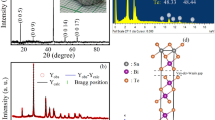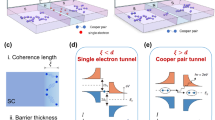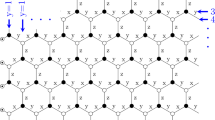Abstract
Tunneling I–V characteristics between very narrow titanium nanowires and “massive” superconducting aluminum were measured. The clear trend was observed: the thinner the titanium electrode, the broader the singularity at eV = Δ1(Al) + Δ2(Ti). The phenomenon can be explained by broadening of the gap edge of the quasi-one-dimensional titanium channels due to quantum fluctuations of the order parameter modulus |Δ2|. The range of the nanowire diameters, where the effect is pronounced, correlates with dimensions where the phase fluctuations of the complex superconducting order parameter Δ = |Δ|eiφ, the quantum phase slips, broadening the R(T) dependencies, have been observed.
Similar content being viewed by others
Background
Over several decades, the tendency for miniaturization of electronic devices could have been described by the Moore’s law: the number of elements on microchips doubles each 18 months. However, nowadays, all authorities (including Gordon Moore himself, the founder of Intel) agree that the Moore’s law soon will come to saturation. According to various prognoses, further integration of commercial nanoelectronic elements is expected to reach stagnation by 2016–2018. Basically, one can figure out two main reasons for such pessimistic forecast. The first one is purely technologic: the dramatic increase of heat dissipation per unit volume (or area). The second reason comes from fundamental properties of electron transport in solids: below certain scales, the behavior of ultra-small elements (rough estimation is about 10 nm) becomes qualitatively different from the properties of macroscopic conductors. In this limit, various quantum phenomena take place driving the device out of conventional (classic) operation mode.
One can naively suggest that a radical solution of the first problem might be the utilization of superconducting elements dissipating zero heat. Indeed already now, superconducting nanoelectronic devices are widely used in various high-tech applications: ultra-sensitive detectors of electromagnetic radiation (e.g., bolometers or transition edge sensors), electric voltage standards utilizing Josephson effect, and quantum bits. Hence, one may tend to use nanoscale superconductors as building blocks of the new generation of nanoelectronic devices. However, already now, there exist both experimental and theoretical studies [1] claiming that below certain scales (of the order of 10 nm), the properties of nanoscale superconductors qualitatively differ from the properties of macroscopic objects. The main reason is the impact of fluctuations which become more pronounced with reduction of the system dimension(s). In addition to undesired contribution “killing” the dissipationless superconducting state, quantum fluctuations are expected to give rise to qualitatively new effects and, correspondingly, should lead to the new generation of nanoelectronic devices.
It is well-known that superconductivity can be described in terms of complex order parameter Δ = |Δ|eiφ. Following the quantum nature of superconductivity, the order parameter can exhibit both classic and quantum fluctuations. The classic (thermal) contribution is important sufficiently close to critical temperature T c, while the impact of quantum fluctuations should be non-negligible within the whole temperature range, including the low-T limit T << T c.
It has been realized that quantum fluctuations of the order parameter Δ = |Δ|eiφ can dramatically modify the properties of sufficiently narrow superconducting channels [1]. The specific manifestation of the phenomenon, related to fluctuations of the phase φ, is called quantum phase slip (QPS). The process corresponds to momentary zeroing of the modulus |Δ| and simultaneous “slip” of the phase φ by ±2π. This leads to several non-trivial effects: finite resistance at temperatures well below the critical point [2–4], suppression of persistent currents in narrow nanorings [5], and coherent superposition of QPSs [6–11]. Here, we present our studies of the related phenomenon-quantum fluctuations of the modulus |Δ| of the order parameter in thin titanium nanowires. We show that the range of the nanowire diameters, where the effect is pronounced, correlates with dimensions where the QPSs, broadening the R(T) dependencies, have been observed.
Theory background
The subject of QPSs has been discussed rather extensively [1, 12, 13]. The rate of QPSs can be expressed as:
where ξ is the coherence length and L is the nanowire length. The QPS action is S QPS = A[R Q/R N][L/ξ(T)], where R N is the sample resistance in normal state, R Q = h/(2e)2 = 6.45 kΩ is the superconducting quantum resistance, and the constant A ≈ 1 is the numerical factor that unfortunately cannot be determined more precisely within the model [12, 13]. The impact of fluctuations exponentially strongly depends on the cross section of a superconductor channel. It can be easily shown that for a given (small) cross section of a nanowire, materials with low critical temperature and high normal state resistivity are of advantage for observation of the QPS effect [1]. In particular, it has been shown that superconducting titanium is the material where QPS effects do exist [4, 5, 7, 9–11].
The magnitude of the related effect—fluctuations of the modulus |Δ|—is determined by the same QPS action [1]:
where \( \left|\tilde{\varDelta}\right| \) stands for the mean value of the order parameter modulus. For ultra-thin superconducting nanowires, where the QPS contribution has been observed, the corresponding effect should be measurable. For example, in titanium nanostructures [4, 5, 7, 9–11], the magnitude of the order parameter modulus might reach an impressive value of ~20 %.
Methods
As the modulus of the order parameter corresponds to the energy gap in excitation spectrum of a superconductor, a straightforward experimental approach would be to measure RF absorption (or reflection) spectra of a quasi-1D nanowire (or an array of similar nanowires) of relevant cross section. The task is doable, but it requires an appropriate expertise and complicated RF equipment that the authors do not have at their disposal. Hence, an alternative approach was selected. It is a common knowledge that I–V tunnel characteristics of a superconductor-insulator-superconductor (SIS) or normal metal-insulator-superconductor (NIS) junction has a singularity at energies eV corresponding to the energy gap of the superconductor(s) [14]. Of particular interest is the S1IS2 configuration, as it provides “sharp” singularity at eV = Δ1(T) + Δ2(T), which is almost temperature independent in the low-T limit T << T c1,2. In practice, the I–V dependencies do demonstrate a certain broadening of the Δ1(T) + Δ2(T) singularity. In addition to the experimental artifacts, undesired impact of EM environment, junction inhomogeneity, etc., the non-zero width of the singularity can be attributed to finite quasiparticle lifetimes, characterized by the Dynes parameter Γ [15]. However, in absolute terms, the mentioned contribution can be made rather small. For example, in aluminum-based SIS structures [16], one can obtain experimental broadening \( \delta \left|{\varDelta}_1+{\varDelta}_2\right|/\left|{\tilde{\varDelta}}_1+{\tilde{\varDelta}}_2\right| < {10}^{-3} \), which is much smaller than the magnitude of the effect we are searching for.
To proceed, we fabricated S1IS2 nanostructures, where S1 stands for the “massive” aluminum electrode and S2 corresponds to counter electrodes in a shape of thin titanium nanowires of various diameters (Fig. 1a, b). The samples were fabricated using PMMA/MAA double-layer lift-off e-beam lithography and directional ultra-high vacuum metal deposition. The nanostructures were formed on the surface of the oxidized silicon. The tunnel barrier “I” was formed by oxidation of the aluminum layer prior to deposition of titanium. Scanning electron and atomic force microscope analyses were used to test the samples. Only those structures which contained no obvious artifacts were further processed. Electron transport measurements were made at ultra-low temperatures in 3He4He dilution refrigerator located inside EM-shielded room. All input/output lines contained multi-stage RLC filters to reduce the impact of noisy EM environment [17].
Results and Discussion
In addition to V–I dependencies, the R(T) characteristics of each titanium nanowire were measured. In accordance with earlier experiments [4, 5, 7, 9–11]; relatively thick samples demonstrated sharp phase transitions, while the thinnest nanowires with an effective diameter < 40 nm, the R(T) transitions were broadened, and their shape could be attributed to the QPS effect (Fig. 1c). The observation supports the expectation that quantum fluctuations are present in the thinnest titanium nanowires studied in this work.
The I–V dependencies between the aluminum S1 and each of the titanium nanowires S2 (Fig. 1b) were the primary subjects of the study. The I–V characteristics were measured at temperatures above and below the critical temperature of thin film superconducting titanium T c(Ti) ≈ 400 mK. Above the critical temperature of titanium, but below the critical temperature of aliminum T c(Al) ≈ 1.4 K, no unexpected features were detected: just a conventional I–Vs of a S1IN2 junction. At low temperatures T << T c(Ti), the I–Vs demonstrated the overall expected shape for a S1IS2 junction (Fig. 2). However, the clear trend was observed: the thinner the S2 (titanium) electrode, the broader the singularity at eV = Δ1(Al) + Δ2(Ti).
First derivative dV/dI characteristic: blow-up of the singularity at eV = Δ1(Al) + Δ2(Ti) of two S1IS2 junctions with two titanium electrodes of different effective diameters d eff equal to 31 and 36 nm (indicated in the inset). One can clearly see that for the thinnest titanium electrode, the absolute value of the mean gap \( \left|{\tilde{\varDelta}}_2\right| \) is smaller and the broadening \( \delta \left|{\varDelta}_2\right|/\left|{\tilde{\varDelta}}_2\right| \) is larger
To account for the observation, we have simulated the I–V dependencies using conventional expression for the tunnel current [14] of a voltage-biased S1IS2 junction (Fig. 3a) with finite “smearing” of the gap Δ2(Ti) assuming Gaussian distribution of the fluctuations (Fig. 3b). Certainly, the utilized model is essentially phenomenologic and does not take into consideration other possible reasons for smearing of the singularity at eV = Δ1(Al) + Δ2(Ti) [16]. However, as all titanium electrodes were fabricated in one experimental run and the measurements were performed within single cool down, one can reasonably assume that “intrinsic” reasons for the singularity broadening (e.g., finite Dynes parameter) should be the same. Hence, one can conclude that what is observed is somehow related to a size effect. We believe that the observation can be explained by the size-dependent contribution of quantum fluctuations of the order parameter modulus |Δ 2|. We hope that our experiments will stimulate further theory studies. Presumably, a comprehensive microscopic theory, in addition to smearing of the gap edge, should also self-consistently calculate the renormalization of the density of states and the distribution function of a superconductor due to quantum fluctuations of the order parameter.
Conclusions
Tunneling I–V characteristics S1IS2 between “massive” aluminum electrode S1 and several titanium nanowires S2 were measured. For the thinnest titanium samples, the clear trend was observed: the thinner the S2 (titanium) electrode, the broader the singularity at eV = Δ1(Al) + Δ2(Ti). We attribute the observation to contribution of quantum fluctuations of the order parameter modulus |Δ 2| of the thin titanium nanowires. The range of the nanowire diameters where the effect is observed correlates with dimensions where the contribution of the phase fluctuations—the quantum phase slips, broadening the R(T) dependencies, have been observed.
References
Arutyunov KY, Golubev DS, Zaikin AD (2008) Superconductivity in one dimension. Phys Rep 464:1–70
Giordano N (1988) Evidence for macroscopic quantum tunneling in one-dimensional superconductors. Phys Rev Lett 61:2137–2140
Bezryadin A, Lau CN, Tinkham M (2000) Quantum suppression of superconductivity in ultrathin nanowires. Nature 404:971–974
Lehtinen JS, Zakharov K, Arutyunov KY (2012) Evidence of quantum phase slip effect in titanium nanowires. Phys Rev B 85:094508 -1 - 094508 -7
Arutyunov KY, Hongisto TT, Lehtinen JS, Leino L, Vasiliev A (2012) Quantum phase slip phenomenon in ultra-narrow superconducting nanorings. Sci Rep 2:213–219
Astafiev OV, Ioffe LB, Kafanov S, Pashkin YA, Arutyunov KY, Shahar D, Cohen O, Tsai JS (2012) Coherent quantum phase slip. Nature (London) 484:355–358
Lehtinen JS, Zakharov K, Arutyunov KY (2012) Coulomb blockade and Bloch oscillations in superconducting Ti nanowires. Phys Rev Lett 109:187001–187004
Hongisto TT, Zorin AB (2012) Single-charge transistor based on the charge-phase duality of a superconducting nanowire circuit. Phys Rev Lett 108:097001-1–097001-5
Lehtinen JS, Arutyunov KY (2012) The quantum phase slip phenomenon in superconducting nanowires with a low-Ohmic environment. Supercond Sci Technol 25:124007-1 - 124007-5
Arutyunov KY, Lehtinen JS, Rantala T (2016) The quantum phase slip phenomenon in superconducting nanowires with high-impedance environment. J Supercond Nov Magn 29:569–572
Arutyunov KY, Lehtinen JS. Junctionless cooper pair transistor. Physica C: superconductivity and its applications. 2016. http://dx.doi.org/10.1016/j.physc.2016.02.010
Zaikin AD, Golubev DS, van Otterlo A, Zimanyi GT (1997) Quantum phase slips and transport in ultrathin superconducting wires. Phys Rev Lett 78:1552–1555
Golubev DS, Zaikin AD (2001) Quantum tunneling of the order parameter in superconducting nanowires. Phys Rev B 64:014504–014507
Tinkham M (1996) Introduction to superconductivity, 2dth edn. McGraw-Hill, Inc., New York
Dynes RC, Narayanamurti V, Garno JP (1978) Direct measurement of quasiparticle-lifetime broadening in a strong-coupled superconductor. Phys Rev Lett 41:1509–1512
Pekola JP, Maisi VF, Kafanov S, Chekurov N, Kemppinen A, Pashkin YA, Saira O-P, Möttönen M, Tsai JS (2010) Environment-assisted tunneling as an origin of the Dynes Density of states. Phys Rev Lett 105:026803–026806
Arutyunov KY, Auraneva H-P, Vasenko AS (2011) Spatially resolved measurement of nonequilibrium quasiparticle relaxation in superconducting aluminium. Phys Rev B 83:104509–104513
Acknowledgements
The results of the project T3-97 “Macroscopic Quantum Phenomena at Low Temperatures”, carried out within the framework of the Basic Research Program at the National Research University Higher School of Economics (HSE) in 2016, are presented in this work.
Authors’ Contributions
KYA initiated the project, suggested interpretation of the results, and wrote the paper. JSL fabricated the nanostructures, performed the measurements, and contributed to some parts of the text. Both authors read and approved the final manuscript.
Competing Interests
The authors declare that they have no competing interests.
Author information
Authors and Affiliations
Corresponding author
Rights and permissions
Open Access This article is distributed under the terms of the Creative Commons Attribution 4.0 International License (http://creativecommons.org/licenses/by/4.0/), which permits unrestricted use, distribution, and reproduction in any medium, provided you give appropriate credit to the original author(s) and the source, provide a link to the Creative Commons license, and indicate if changes were made.
About this article
Cite this article
Arutyunov, K.Y., Lehtinen, J.S. Quantum Fluctuations of a Superconductor Order Parameter. Nanoscale Res Lett 11, 364 (2016). https://doi.org/10.1186/s11671-016-1582-7
Received:
Accepted:
Published:
DOI: https://doi.org/10.1186/s11671-016-1582-7







